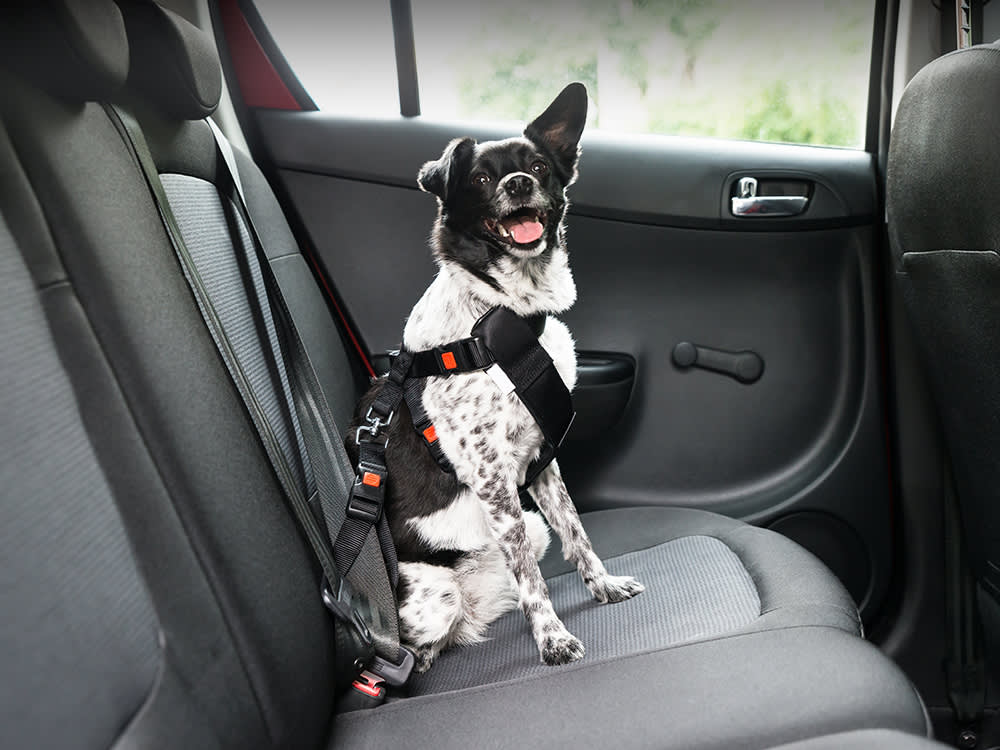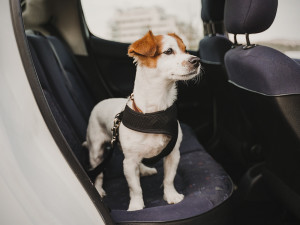Driving Your Newly Adopted Dog Home
People do this in many ways, and some are safer than others.

share article

Your pet wants you to read our newsletter. (Then give them a treat.)
The first time you put your newly adopted pup in your car — or truck or rental — is a big deal. It’s also a moment to think about their safety, not just on this first trip, but forever. Over the years, the two of you will no doubt share many road tripsopens in a new tab, so if possible, it’s good to start off on the right foot (and paw).
As a canine behavioralist, I’d like to see all those pups headed home in the safest, most comfortable way possible. Here are the ways I have seen dogs being transported, with what I consider to be the pros and cons of each method.
Being held by a passenger.
On the plus side, physical contact can accelerate the development of close ties between dogs and their humans. For dogs who enjoy it, being held makes them feel secure. Dogs who prefer more personal space tend to find it less welcome. When the dog is being held, they are prevented from moving around the vehicle, possibly hurting themselves or distracting the driver, which can lead to a dangerous situation. On the other hand, humans can’t prevent dogs from becoming missiles in the event of an accident or other sudden stop, so overall, this is not the safest way to transport a new dogopens in a new tab home. (Remember, for safety’s sake, the driver should not be the one to hold the dog.)
In A Crate.
Confined in a crateopens in a new tab is a far safer way for dogs to travel, and I’m a big fan of using them. On the plus side, in addition to the safety factor, crating the dog prevents potential mess-makers (vomitopens in a new tab, urine, slobber or hair, for example) from getting all over the rest of the car. On the downside, some dogs absolutely panic in a crate or are so distressed by being in one that it may not be worth it to insist.
Restrained With A Harness And Seat Belt Or Zipline.
These options have the benefit of safety because the dog can’t go flying in the event of an accident or sudden stop, and can’t run amok in the car. Being tethered to a small area helps keep the dog (and everyone else on the road) safe. This method of restraint will work for most dogs — even those who are panicky about confinement. Only a few really freak out in a harnessopens in a new tab, although some do fuss about it a bit. With these forms of restraint, a dog can snuggle up to a passenger, which often gives comfort to a dog heading into the great unknown (unknown, at least, from the dog’s perspective).
On The Seat.
Many dogs are happy to be on the seat, but without some form of restraint, they’re potentially at risk if there’s a short stop or an accident. Most dogs seem relaxed in this situation, but it’s not relaxing for me to see. However, if a dog is going to be transported loose in the car (which I don’t recommend), being on the back seat is safer than being on the front seat.
On The Floor.
Riding on the floor of a car behind the front seats is safer than being in the front, where the dog might distract or interfere with the driver. It’s also somewhat safer than sitting on the seat, but since the dog is not secured, there’s still a risk with this method. If a dog chooses to be on the floor, they may do so because it feels to them like a more secure space. This suggests that a crate may be a good option for this particular dog, now or in the future.
Behind A Dog Guard.
A guard that blocks off the back seat is a great option. This prevents the dog from being loose in the car, and from flying into (or through) the windshield in the event of an accident or a sudden stop. Many dogs are comfortable in such a setup, and it’s a good long-term transport strategy. If used when the dog is being brought home, it’s nice to have a person in the back seat to offer company and comfort. But even if you’re driving by yourself, this is a safe option for you and for the dog.
In The Back Of A Pick-Up Truck.
This is the worst possible option, especially for a dog who has not yet developed a bond with you. Practically anything could cause the dog to freak out and try to escape. Shelter dogs’ histories are usually pretty scant, which means you have no way of knowing if a truck bed is a second home for your new dog or so unfamiliar that it could cause her terror, especially once you’re on the road.

Karen B. London, PhD, CAAB, CPDT-KA
Karen B. London, Ph.D., is a Certified Applied Animal Behaviorist and Certified Professional Dog Trainer who specializes in working with dogs with serious behavioral issues, including aggression, and has also trained other animals including cats, birds, snakes, and insects. She writes the animal column for the Arizona Daily Sun and is an Adjunct Professor in the Department of Biological Sciences at Northern Arizona University. She is the author of six books about training and behavior, including her most recent, Treat Everyone Like a Dog: How a Dog Trainer’s World View Can Improve Your Lifeopens in a new tab.
Related articles
![Jack Russell dog in backseat of s car wearing a safety harness and seat belt]() opens in a new tab
opens in a new tabHow to Keep Your Dog Safe in the Car
Hitting the road with your dog? Make sure they're safe with this helpful advice.
![Puppy laying in torn up paper on the couch]() opens in a new tab
opens in a new tabNew Puppy Driving You Nuts? Here’s How to Deal
The beginning of puppy parenthood can be rough, but it does get better — especially when you implement this advice.

